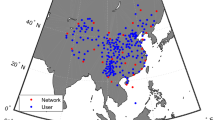Abstract
Synchronized pseudolite systems allow single-point positioning (SPP) using carrier-phase measurements with centimeter-level accuracy. Locata, developed by the Locata Corporation, emerged from the development of synchronized pseudolite technology. Numerous studies have claimed to achieve Locata SPP with centimeter-level accuracy; however, the ambiguities of Locata observations have been typically estimated as floating-point values. Similar to precise point positioning of global navigation satellite systems, pseudolite SPP that is based on ambiguity fixing can improve the positioning accuracy and shorten the convergence time, compared to the float solution. However, integer ambiguity fixing may be prevented due to the clock offset among the pseudolite transmitters. To recover the integer nature of single-difference ambiguity, a fractional cycle bias (FCB) correction method is proposed; this method is based on two-way time synchronization. The FCB correction method employed to estimate and correct the bias by a pseudolite network itself has two steps: two-way FCB measurement and half-cycle bias estimation. A ground-based testbed is constructed to test and verify the proposed method. It is shown that the FCB between the pseudolite transmitters have a stability better than 15 ps even considering the influence of variable multipath delay; the bias can be estimated with high precision and reliability. Statistical results support the theoretical findings that half-cycle bias may be caused by two-way clock offset measuring via carrier phase measurement. A two-dimensional positioning experiment is performed to evaluate the performance of the proposed FCB correction method. The single-difference ambiguities are fixed to integer values using the LAMBDA method with the fixed failure-rate ratio test. The results indicated that the positioning accuracy is at the sub-centimeters to centimeter-level compared with the real-valued solutions for all surveyed points.
















Similar content being viewed by others
References
Barnes J, Rizos C, Wang J, Small D, Voigt G, Gambale N (2003a) Locata: the positioning technology of the future. In: 6th international symposium on satellite navigation technology including mobile positioning & location services, Melbourne, 22–25 July, CD-ROM proc. paper 49
Barnes J, Rizos C, Wang J, Small D, Voigt G, Gambale N (2003b) Locata: a new positioning technology for high precision indoor and outdoor positioning, In: proceedings of ION-GPS/GNSS-2003, Institute of Navigation, Portland, Sept 9–12, pp 1119–1128
Bertsch J, Choudhury M, Rizos C, Kahle H (2009) On-the-fly ambiguity resolution for Locata. In: international symposium on GPS/GNSS, Gold Coast, Dec 1–3, CD-ROM procs
Borio D, Gioia C (2016) Asynchronous pseudolite navigation using C/N0 measurements. J Navig 69(3):639–658
Choudhury M, Harvey BR, Rizos C (2009) Tropospheric correction for Locata when known point ambiguity resolution technique is used in static survey—is it required? In: Proceedings of the international symposium on GPS/GNSS, Gold Coast, Dec 1–3, CD-ROM procs
Cobb HS (1997) GPS pseudolites: theory, design and applications, Ph.D. thesis at Stanford University
Freeland R, Buschermohle M, Nichols W (2014) Precision agriculture: RTK base-to-tractor range limitations using RF communication. Appl Eng Agric 30(1):97–104
Fujieda M, Piester D, Gotoh T, Becker J, Aida M, Bauch A (2014) Carrier-phase two-way satellite frequency transfer over a very long baseline. Metrologia 51(3):253–262
Ge M, Gendt G, Rothacher M, Shi C, Liu J (2008) Resolution of GPS carrier-phase ambiguities in precise point positioning (PPP) with daily observations. J Geod 82(7):389–399
Geng J, Teferle FN, Shi C, Meng X, Dodson AH, Liu J (2009) Ambiguity resolution in precise point positioning with hourly data. GPS Solutions 13(4):263–270
Guo X, Zhou Y, Yang J (2015) Research on Time Synchronization Method of Ground-Based Navigation System. In: Proceedings of CSNC-2015, Springer, Berlin Heidelberg, Vol I, 529–536
Guo X, Zhou Y, Yang J, Liu K, Liu C (2018) Precise point positioning for ground–based navigation systems without accurate time synchronization. GPS Solut 22:34
Jiang W, Li Y, Rizos C (2013) On-the-fly Locata/inertial navigation system integration for precise maritime application. Meas Sci Technol 24(10):105104
Jiang W, Li Y, Rizos C (2014) On-the-fly indoor positioning and attitude determination using terrestrial ranging signals. In: Proceedings of ION-GNSS-2014, Institute of Navigation, Tampa, Sept 8–12, pp 3222–3230
Jiang W, Li Y, Rizos C (2015) Locata-based precise point positioning for kinematic maritime applications. GPS Solut 19(1):117–128
Jiang W, Li Y, Rizos C, Cai B, Wei S (2017) Seamless indoor-outdoor navigation based on GNSS, INS and terrestrial ranging techniques. J Navig 70(6):1–22
Kee C, Jun H, Yun D (2003) Indoor navigation system using asynchronous pseudolites. J Navig 56:443–455
Kim C, So H, Lee T, Kee C (2014) A pseudolite-based positioning system for legacy GNSS receivers. Sensors 14(4):6104–6123
Liang Z, Lv H, Wang D, Hou Y, Wu J (2015) Asynchronous RTK precise DGNSS positioning method for deriving a low-latency high-rate output. J Geod 89(7):641–653
Montillet JP, Roberts GW, Hancock C, Meng X, Ogundipe O (2009) Deploying a Locata network to enable precise positioning in urban canyons. J Geod 83(2):91–103
Montillet JP, Hancock C, Bonenberg LK, Roberts GW (2014) On the improvements of the single point positioning accuracy with Locata technology. GPS Solut 18(2):117–128
Powers E, Colina A (2016) Wide area wireless network synchronization using Locata. In: Proceedings of the 47th annual precise time and time interval systems and applications meeting, Monterey, Jan 25–28, pp 90–98
Teunissen PJG, Verhagen S (2009) The GNSS ambiguity ratio-test revisited: a better way of using it. Surv Rev 41:138–151
Wang J (2002) Applications of pseudolites in geodetic positioning: progress and problems. J Glob Position Syst 1(1):48–56
Zhang Y, Wang Q, Jiang X (2017) Property analysis of the real-time uncalibrated phase delay product generated by regional reference stations and its influence on precise point positioning ambiguity resolution. Sensors 17(5):1162–1176
Author information
Authors and Affiliations
Corresponding author
Rights and permissions
About this article
Cite this article
Liu, K., Yang, J., Guo, X. et al. Correction of fractional cycle bias of pseudolite system for user integer ambiguity resolution. GPS Solut 22, 105 (2018). https://doi.org/10.1007/s10291-018-0771-5
Received:
Accepted:
Published:
DOI: https://doi.org/10.1007/s10291-018-0771-5




